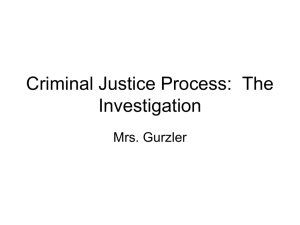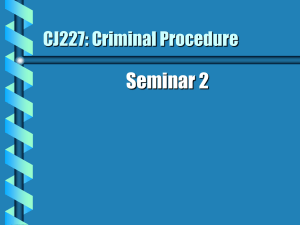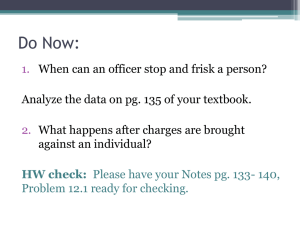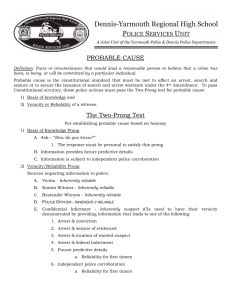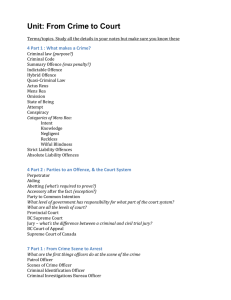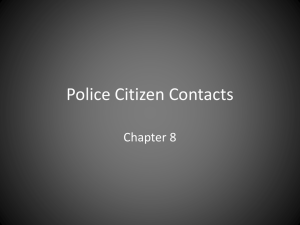Introduction to Constitutional Law Unit 6
advertisement
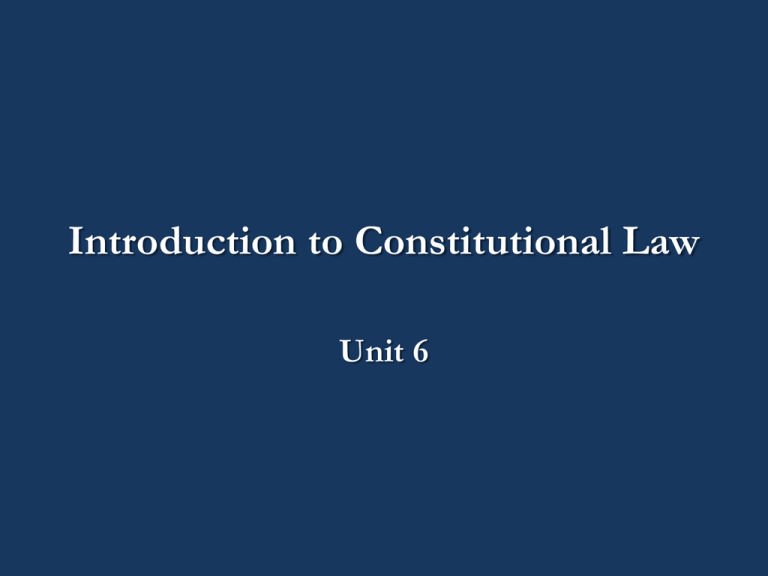
Introduction to Constitutional Law Unit 6 CJ140-02A – Introduction to Constitutional Law Unit 6: The Fourth Amendment CJ140-01 Tonight’s Topic • Discussion of the Fourth Amendment with the following goals in mind: – Identify the elements of an arrest – Describe when an arrest may be legally made – Explain what the knock-and-announce rule requires – Recognize how much force can be used in making an arrest Bill of Rights Amendment 4 IV - Right of search and seizure regulated • The right of the people to be secure in their persons, houses, papers, and effects, against unreasonable searches and seizures, shall not be violated, and no warrants shall issue, but upon probable cause, supported by oath or affirmation, and particularly describing the place to be searched, and the persons or things to be seized. • Protects against unreasonable searches and seizures of: – Persons – Houses – Papers – Effects From Government Actors Police Officers Governmental Agents in any Capacity Definition of Reasonable Suspicion “…an officer may, consistent with the Fourth Amendment, conduct a brief, investigatory stop when the officer has a reasonable, articulable suspicion that criminal activity is afoot. While ‘reasonable suspicion’ is a less demanding standard than probable cause and requires a showing considerably less than preponderance of the evidence, the Fourth Amendment requires at least a minimal level of objective justification for making the stop. The officer must be able to articulate more than an ‘inchoate and unparticularized suspicion or 'hunch' of criminal activity.” Illinois v. Wardlow, 528 U.S. 119, 123-24 (2000) (citations omitted). Definition of Probable Cause “Probable cause exists where the facts and circumstances within their [the officers'] knowledge and of which they had reasonably trustworthy information [are] sufficient in themselves to warrant a man of reasonable caution in the belief that’ an offense has been or is being committed.” Brinegar v. United States, 338 U.S. 160, 175-76 ( 1949) (quoting Carroll v. United States, 267 U.S. 132, 162 (1925)). Arrest The taking of a person into custody in the manner authorized by law. Arrested person may be subjected to reasonable restraints. There must be probable cause or a warrant to arrest. If the arrest is lawful, the person may be searched. Arrests and Detentions • When does seizure occur? – Reasonable person would believe that he/she is not free to leave • Physical application of force or submission to officer’s show of force • What is required for arrest? – Probable Cause – what is it? • When is a warrant not required? Arrest without a Warrant? • Most common form of arrest. • Courts have held that to require a warrant for every arrest is impractical. • Police generally may not enter a private home to make a warrantless arrest. • Exception to above is when exigent circumstances exist. How does a police officer obtain an warrant? • A written order issued by a judicial officer upon a showing of probable cause commanding the arrest of a particular person. • May take some time • Approval by a prosecutor • Confidential Informants? • Some jurisdictions allow the use of telephonic arrest warrants. Issues surrounding arrest • Stop and Frisk: What is it? • How does the 4th Amendment direct police officers during interaction with suspects….or those who may become suspects? • What is “reasonable and articulable suspicion?” Deadly Force • Deadly force is a seizure • Significant threat to officer or others • Shocking to the conscience Terry v. Ohio • On the continuum of contacts…this falls between a mere street encounter (no intrusion by law enforcement) and arrest (custody, substantial intrusion by law enforcement) • Where intrusiveness is minimal, the standard of “reasonable and articulable suspicion” is sufficient. • Developed the concept of stop and frisk. Temporary Questioning? • Temporary detention for questioning is not an arrest. • If police restraint goes beyond that which is reasonably necessary for questioning, the temporary detention may ripen into an arrest. • Example……… • Detention is ordinarily for a fairly short duration before it becomes an arrest. What are the rules during a “temporary detention?” • Investigative Stop: Police may temporarily detain a person if officer has a reasonable suspicion that criminal activity may be involved. • Frisk: The officer may pat down the individual for weapons ONLY if the officer has additional reasonable suspicion that the pat down is necessary for safety reasons. • So….may an officer “pat down” a suspect if the officer “reasonably and articulably” believes that the suspect may possess drugs on his person? Why? Searches in Foreign Countries/Border Fourth Amendment does not apply to searches/seizures by US Officials in foreign countries involving non-US Citizens. National sovereignty doctrine removes Fourth Amendment protections to non-citizens and citizens alike at the border or border equivalent. Roving Patrols near the border – what is okay? Exclusionary Rule • Prohibits evidence obtained in violation of constitutional rights. Exclusionary Rule - Exceptions • Inevitable Discovery – Would have inevitably be discovered through lawful means • Good Faith – Officers acting honestly and unaware acting in violation of rights – usually with defective warrants • Some states do not have this exception Questions?
